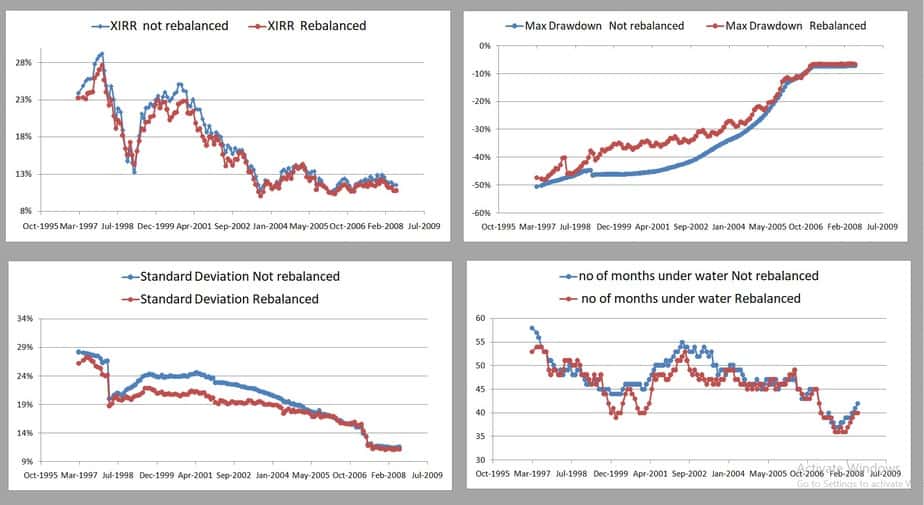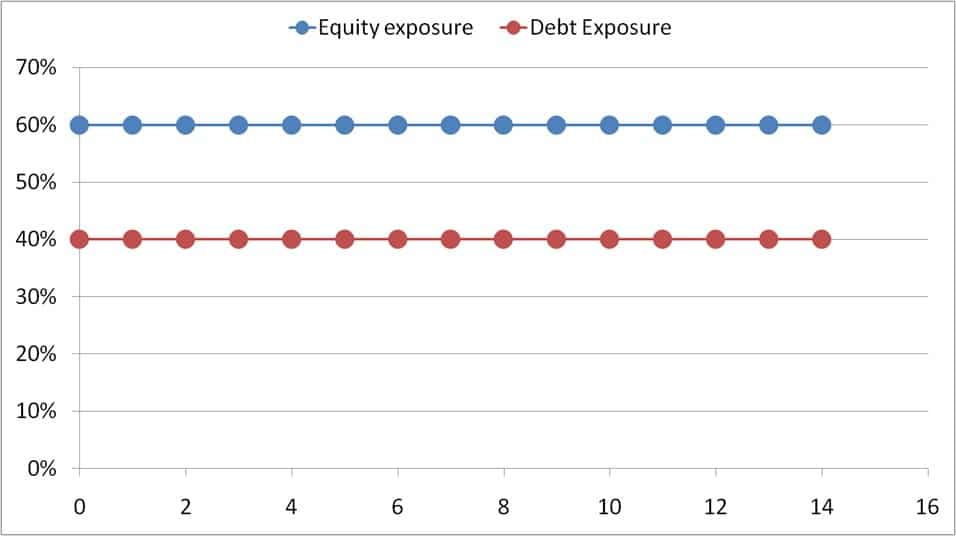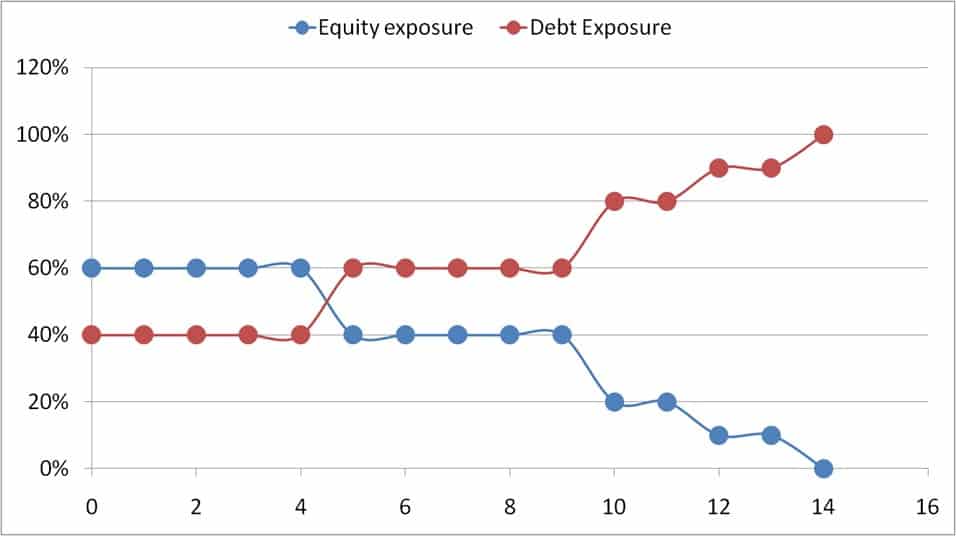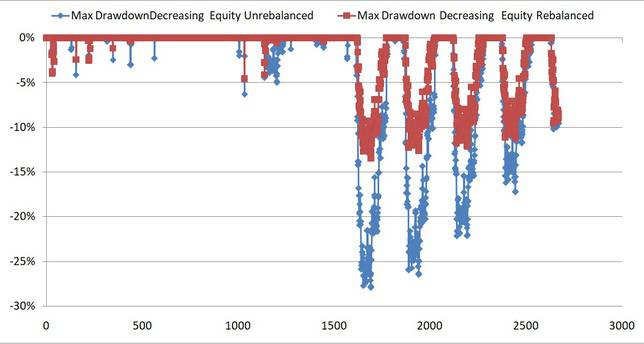Last Updated on September 15, 2025 at 11:59 am
Portfolio rebalancing refers to resetting your asset allocation (equity: fixed income ratio) from time to time – typically once a year – to lower risk in your portfolio. In this post, I show backtesting results and discuss exactly how much is the risk reduction and in spite of tax and exit loads, it is totally worthwhile to rebalance the portfolio.
This post is part of Resolve – a series of steps on investing and portfolio management.
Step1: How to quickly select equity mutual funds and build a diversified portfolio
Step 2: How to Quickly Decide: Should I stay invested or exit my mutual fund?
Join 32,000+ readers and get free money management solutions delivered to your inbox! Subscribe to get posts via email! (Link takes you to our email sign-up form)
🔥Want to create a complete financial plan? Learn goal-based investing? Exclusive access to our DIY tools? Increase your income with your skills? Use this link to enjoy massive discounts on our robo-advisory tool & courses! 🔥
Step 4: Why we need to gradually pull out of equity investments well before we need the money!
Step 5: How much equity should I hold in my portfolio?
Step 6: this post.
What is asset allocation?
You decide the asset classes that you want to invest in, say equity and fixed income. You have an expectation of return for the duration of investment and an expectation of risk. Based on this you decide how much equity should be there in your portfolio and how much-fixed income. First, let us have a look at the basics of asset allocation.
Then as discussed earlier: how much equity should I have in my portfolio?
What is portfolio rebalancing?
Suppose you start with 60% equity and 40% fixed income and after one year, you have 80% equity and 20% fixed income (bumper returns from stock market). You sell the excess 20% from equity and buy more fixed income and reset the asset allocation back to 60:40. The basics are explained here.
Remember portfolio rebalancing requires the maturity to partially pull out of a well-performing asset class and shift it to another asset class!

Previous posts about rebalancing:
The What, Why, How and When of Portfolio Rebalancing With Calculators to Boot
How to Rebalance Your Investment Portfolio
Understanding Volatility of Investment Returns with a Portfolio Rebalancing Simulator
Why should I rebalance?
Reduce risk in the portfolio. Remember risk is real-time and return is in hindsight. Rebalancing reduced risk in real time and keeps the investor calm as we will see below.
It is clear to me now that many investors want better returns and lower risk without selling and buying because of taxation and exit load fears. This is as immature as checking the portfolio each day.
Example 1: 10-year duration; Equity 60%; Fixed Income 40%
Here equity is Franklin India Blue Chip Fund and Fixed Income is Franklin Dynamic Accrual Fund (previously Templeton India Income Fund)

Top left: Returns (XIRR) are compared between systematic investing (60:40) with rebalancing each year and no rebalancing.
Top right: The max drawdown or max fall the portfolio saw is compared. The more negative, the worse!
Bottom left: The fluctuation in monthly returns (standard deviation) is compared. The higher, the more volatile.
Bottom right: Total no of months, the portfolio “fell” leading to negative monthly returns.
Annual rebalancing clearly has a lower risk. I have removed 4% from the final value to account for tax and exit load. This is the reason why the rebalanced returns are bit lower.
Example 2: 10-year duration; Equity 70%; Fixed Income 30%

Again the same benefit. Please don’t be childish and assume: “the un-rebalanced return is anyway good so why should I rebalance?” Let me repeat: returns are in hindsight (you will know only at the end) and risk is in real time (every day).
Example 3: 15-year duration; Equity 60%; Fixed Income 40%
This is from scenario considered here: How to reduce risk in an investment portfolio. This is the asset allocation plan.

The max fall in the portfolio is compared for annual rebalancing to 60:40 and no rebalancing.
The drawdown risk is lowered by 10% due to simple annual rebalancing.
Example 4: 15-year duration; Decreasing Equity
This is the step-down strategy used. Read more: Why we need to gradually pull out of equity investments well before we need the money!

So here rebalancing means: for the 1st five years, the portfolio is annual reset to 60:40 and in 6th year to 40:60 (equity = 40) and then reset at 40:60 for next 4 years and then down to 20:80 ( equity = 20) and so on.
No rebalancing means: Starting at 60:40, and rebalance to 40:60 only in the 6th year and rebalance to 20:80 only 11th year and so on. No rebalancing is done in between
Here again, the benefit is a 10% reduction in risk.
So the message is clear, forget about tax, forget about exit load. Whether you follow a decreasing equity strategy or a constant equity strategy, reset your portfolio asset allocation once a year and sleep peacefully. No need to time the market, no need to worry about market outlook and all that nonsense. Of course, first you should have a strategy in place and only then can you worry about rebalancing. Do you?

Use our Robo-advisory Tool to create a complete financial plan! ⇐More than 3,000 investors and advisors use this! Use the discount code: robo25 for a 20% discount. Plan your retirement (early, normal, before, and after), as well as non-recurring financial goals (such as child education) and recurring financial goals (like holidays and appliance purchases). The tool would help anyone aged 18 to 80 plan for their retirement, as well as six other non-recurring financial goals and four recurring financial goals, with a detailed cash flow summary.
🔥You can also avail massive discounts on our courses and the freefincal investor circle! 🔥& join our community of 8000+ users!
Track your mutual funds and stock investments with this Google Sheet!
We also publish monthly equity mutual funds, debt and hybrid mutual funds, index funds, and ETF screeners, as well as momentum and low-volatility stock screeners.
You can follow our articles on Google News

We have over 1,000 videos on YouTube!

Join our WhatsApp Channel



- Do you have a comment about the above article? Reach out to us on Twitter: @freefincal or @pattufreefincal
- Have a question? Subscribe to our newsletter using the form below.
- Hit 'reply' to any email from us! We do not offer personalised investment advice. We can write a detailed article without mentioning your name if you have a generic question.
Join 32,000+ readers and get free money management solutions delivered to your inbox! Subscribe to get posts via email! (Link takes you to our email sign-up form)
About The Author
 Dr M. Pattabiraman (PhD) is the founder, managing editor and primary author of freefincal. He is an associate professor at the Indian Institute of Technology, Madras. He has over 13 years of experience publishing news analysis, research and financial product development. Connect with him via Twitter(X), LinkedIn, or YouTube. Pattabiraman has co-authored three print books: (1) You can be rich too with goal-based investing (CNBC TV18) for DIY investors. (2) Gamechanger for young earners. (3) Chinchu Gets a Superpower! for kids. He has also written seven other free e-books on various money management topics. He is a patron and co-founder of “Fee-only India,” an organisation promoting unbiased, commission-free, AUM-independent investment advice.
Dr M. Pattabiraman (PhD) is the founder, managing editor and primary author of freefincal. He is an associate professor at the Indian Institute of Technology, Madras. He has over 13 years of experience publishing news analysis, research and financial product development. Connect with him via Twitter(X), LinkedIn, or YouTube. Pattabiraman has co-authored three print books: (1) You can be rich too with goal-based investing (CNBC TV18) for DIY investors. (2) Gamechanger for young earners. (3) Chinchu Gets a Superpower! for kids. He has also written seven other free e-books on various money management topics. He is a patron and co-founder of “Fee-only India,” an organisation promoting unbiased, commission-free, AUM-independent investment advice.Our flagship course! Learn to manage your portfolio like a pro to achieve your goals regardless of market conditions! ⇐ More than 3,500 investors and advisors are part of our exclusive community! Get clarity on how to plan for your goals and achieve the necessary corpus no matter the market condition!! Watch the first lecture for free! One-time payment! No recurring fees! Life-long access to videos! Reduce fear, uncertainty and doubt while investing! Learn how to plan for your goals before and after retirement with confidence.
Increase your income by getting people to pay for your skills! ⇐ More than 800 salaried employees, entrepreneurs and financial advisors are part of our exclusive community! Learn how to get people to pay for your skills! Whether you are a professional or small business owner seeking more clients through online visibility, or a salaried individual looking for a side income or passive income, we will show you how to achieve this by showcasing your skills and building a community that trusts and pays you. (watch 1st lecture for free). One-time payment! No recurring fees! Life-long access to videos!
Our book for kids: “Chinchu Gets a Superpower!” is now available!


Must-read book even for adults! This is something that every parent should teach their kids right from their young age. The importance of money management and decision making based on their wants and needs. Very nicely written in simple terms. - Arun.Buy the book: Chinchu gets a superpower for your child!
How to profit from content writing: Our new ebook is for those interested in getting a side income via content writing. It is available at a 50% discount for Rs. 500 only!
Do you want to check if the market is overvalued or undervalued? Use our market valuation tool (it will work with any index!), or get the Tactical Buy/Sell timing tool!
We publish monthly mutual fund screeners and momentum, low-volatility stock screeners.
About freefincal & its content policy. Freefincal is a News Media organisation dedicated to providing original analysis, reports, reviews and insights on mutual funds, stocks, investing, retirement and personal finance developments. We do so without conflict of interest and bias. Follow us on Google News. Freefincal serves more than three million readers a year (5 million page views) with articles based only on factual information and detailed analysis by its authors. All statements made will be verified with credible and knowledgeable sources before publication. Freefincal does not publish paid articles, promotions, PR, satire or opinions without data. All opinions will be inferences backed by verifiable, reproducible evidence/data. Contact Information: To get in touch, please use our contact form. (Sponsored posts or paid collaborations will not be entertained.)
Connect with us on social media
- Twitter @freefincal
- Subscribe to our YouTube Videos
- Posts feed via Feedburner.
Our publications
You Can Be Rich Too with Goal-Based Investing
 Published by CNBC TV18, this book is designed to help you ask the right questions and find the correct answers. Additionally, it comes with nine online calculators, allowing you to create custom solutions tailored to your lifestyle. Get it now.
Published by CNBC TV18, this book is designed to help you ask the right questions and find the correct answers. Additionally, it comes with nine online calculators, allowing you to create custom solutions tailored to your lifestyle. Get it now.Gamechanger: Forget Startups, Join Corporate & Still Live the Rich Life You Want
 This book is designed for young earners to get their basics right from the start! It will also help you travel to exotic places at a low cost! Get it or gift it to a young earner.
This book is designed for young earners to get their basics right from the start! It will also help you travel to exotic places at a low cost! Get it or gift it to a young earner.Your Ultimate Guide to Travel
 This is an in-depth exploration of vacation planning, including finding affordable flights, budget accommodations, and practical travel tips. It also examines the benefits of travelling slowly, both financially and psychologically, with links to relevant web pages and guidance at every step. Get the PDF for Rs 300 (instant download)
This is an in-depth exploration of vacation planning, including finding affordable flights, budget accommodations, and practical travel tips. It also examines the benefits of travelling slowly, both financially and psychologically, with links to relevant web pages and guidance at every step. Get the PDF for Rs 300 (instant download)
